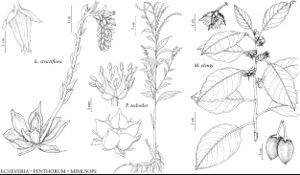Echeveria
in A. P. de Candolle and A. L. P. P. de Candolle, Prodr. 3: 401. 1828 ,.
Herbs [shrubs], perennial, not viviparous, [0.2–]2.5[–6] dm, glabrous [pubescent]. Stems erect, mostly branching, succulent; floral stems annual, from leaf axil, overtopping rosette, with scattered smaller leaves. Leaves falling after withering, crowded in rosette, alternate, sessile, not connate basally; blade oblanceolate to broadly rhombic [ovate-deltate to elliptic or oblanceolate], laminar, 3–11[–40] cm, fleshy, base not spurred, margins entire; with 1 vein entering margins. Inflorescences lateral cymes [racemes or spikes]. Pedicels present. Flowers (not fetid), erect, ascending, or pendent, 5-merous; sepals ascending, distinct, unalike in size; petals erect, connate basally, forming sharply 5-gonal–pyramidal tube, deep pink, yellow adaxially, (triquetrous [thinner]); calyx and corolla not circumscissle; nectaries truncate, wider than high; stamens 10; filaments adnate to corolla base; pistils erect and appressed, nearly distinct; ovary base not narrowed, tapering to styles; styles 2+ times shorter than ovary. Fruits erect to spreading. Seeds ovoid, reticulate. x = ca. 34.
Distribution
Tex., Mexico, Central America, South America (Argentina).
Discussion
Species ca. 120 (1 in the flora).
Echeveria is a remarkable group in which diploid species have anywhere from 12 to 34 chromosome pairs and polyploid species have from 28 to about 260 (C. H. Uhl 1992, 1995). Uhl concluded that the ancestral number was probably about x = 34, with a descending series to n = 12, and that plants with higher numbers are mostly autoploid. He found Echeveria to be part of a giant comparium that also includes Graptopetalum, Lenophyllum, Pachyphytum, Villadia, and others, as well as many Mexican species of Sedum, but not Dudleya.
